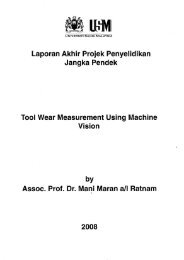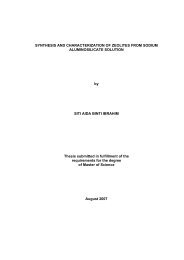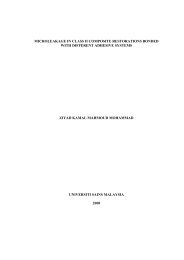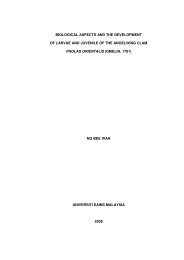design and development of a secure wireless ... - ePrints@USM
design and development of a secure wireless ... - ePrints@USM
design and development of a secure wireless ... - ePrints@USM
You also want an ePaper? Increase the reach of your titles
YUMPU automatically turns print PDFs into web optimized ePapers that Google loves.
signals with the PN sequence (Simon et al., 1985). However, in-b<strong>and</strong> pulse RFI,<br />
e.g., a radar signal whose frequency is in the desired signal data b<strong>and</strong>, can<br />
seriously degrade the PN system which is operating in a linear channel,<br />
because peak power <strong>of</strong> the pulse RFI is much stronger than the PN spread<br />
signal power. Hence, a s<strong>of</strong>t-limiter at the front end <strong>of</strong> the receiver has been<br />
used for second generation transponder, which is also recommended for the<br />
<strong>design</strong> <strong>of</strong> the Space Station Freedom (SSF) S-b<strong>and</strong> PN system.<br />
Several methods have been proposed for the calculation <strong>of</strong> the effect <strong>of</strong><br />
memoryless non-linearties on the sum <strong>of</strong> input signals. Of these, the transform<br />
method (Davenport <strong>and</strong> Root, 1958; Blachman, 1971) is widely applicable. For<br />
PN spread-spectrum signals, this method cannot give a complete analysis<br />
because it does not supply phase information about the output signals (Baer,<br />
1992). A modified transform method which use the transfer characteristic <strong>of</strong> the<br />
nonlinear device as suggested by Davenport <strong>and</strong> Root (1958) <strong>and</strong> apply a timedomain<br />
approach has been used to study interference effects <strong>of</strong> hard-limiting in<br />
PN spread-spectrum systems ( Baer,1992).<br />
2.3.2 Fast Frequency Hopping Spread Spectrum <strong>and</strong> Jamming Systems<br />
Spasojevic <strong>and</strong> Burns (2000) presented the report analyses <strong>of</strong> two main spread<br />
spectrum (SS) technologies used by <strong>wireless</strong> devices in the 2.4GHz ISM b<strong>and</strong>.<br />
The authors compared the technical characteristics <strong>of</strong> frequency hope spread<br />
spectrum (FHSS) <strong>and</strong> direct sequence spread spectrum (DSSS). They used<br />
indoor <strong>and</strong> outdoor radio local area network (RLAN) densities <strong>of</strong> 100 <strong>and</strong> 1 per<br />
23

















